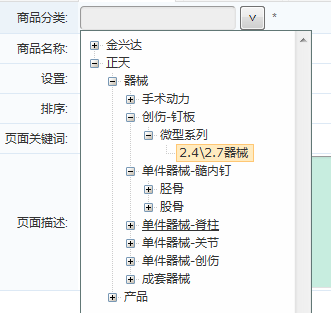zTree插件下拉樹使用入門教程
編輯:關於JavaScript
最近,因為工作需要一個樹形下拉框的組件,經過查資料一般有兩種的實現方法。其一,就是使用zTree實現;其二,就是使用easyUI實現。因為公司的前端不是使用easyUI設計的,故這裡我選擇了zTree來實現下拉樹。
這裡使用簡單的數據格式(即簡單的Json格式)類似如下Json:
var zNodes =[
{id:1, pId:0, name:"北京"},
{id:2, pId:0, name:"天津"},
{id:3, pId:0, name:"上海"},
{id:6, pId:0, name:"重慶"},
{id:4, pId:0, name:"河北省", open:true, nocheck:true},
{id:41, pId:4, name:"石家莊"},
{id:42, pId:4, name:"保定"},
{id:43, pId:4, name:"邯鄲"},
{id:44, pId:4, name:"承德"},
{id:5, pId:0, name:"廣東省", open:true, nocheck:true},
{id:51, pId:5, name:"廣州"},
{id:52, pId:5, name:"深圳"},
{id:53, pId:5, name:"東莞"},
{id:54, pId:5, name:"佛山"},
{id:6, pId:0, name:"福建省", open:true, nocheck:true},
{id:61, pId:6, name:"福州"},
{id:62, pId:6, name:"廈門"},
{id:63, pId:6, name:"泉州"},
{id:64, pId:6, name:"三明"}
];
這裡首先需要一個實體bean,用來封裝對應查出來的數據,如下:
public class ZtreeNode {
// id
private String id;
// 父id
private String pId;
// 顯示名稱
private String name;
// 是否打開 (這裡默認是不打開的,如果需要打開,設為true)
// private boolean open ;
// 能否選擇 (設置節點是否能夠選擇,默認都能選擇,設為true對應的節點不能選擇)
// private boolean nocheck ;
/**getter and setter*/
}
這裡需要注意的是 pId 中的第二的字母是大寫的,如果寫成小寫的就不能構造成樹形結構,所有的都是根節點。
然後,將從數據庫中查出來的數據,轉換為對應的ztree需要的bean,再轉換為相應的Json,代碼如下:
// 獲取商品分類樹 返回json
public String getGoodsCategoryTreeJson() {
List<GoodsCategory> allGoodsCategoryList = goodsCategoryService.getGoodsCategoryTreeJson() ;
List<ZtreeNode> ztreelist = new ArrayList<ZtreeNode>();
for(GoodsCategory gcty : allGoodsCategoryList){
ZtreeNode treenade = new ZtreeNode();
treenade.setId(gcty.getId());
treenade.setpId(gcty.getParent()==null?"":gcty.getParent().getId());
treenade.setName(gcty.getName());
ztreelist.add(treenade);
}
return ajax(ztreelist);
}
將list轉換為對應的Json方法,如下:
用到的Json工具包:
import org.springframework.base.util.JsonUtil;
private static final String HEADER_ENCODING = "UTF-8";
private static final boolean HEADER_NO_CACHE = true;
private static final String HEADER_TEXT_CONTENT_TYPE = "text/plain";
private static final String HEADER_JSON_CONTENT_TYPE = "text/plain";
// AJAX輸出
protected String ajax(String content, String contentType) {
try {
HttpServletResponse response = initResponse(contentType);
response.getWriter().write(content);
response.getWriter().flush();
} catch (IOException e) {
e.printStackTrace();
}
return NONE;
}
// 根據文本內容輸出AJAX
protected String ajax(String text) {
return ajax(text, HEADER_TEXT_CONTENT_TYPE);
}
// 根據操作狀態輸出AJAX
protected String ajax(Status status) {
HttpServletResponse response = initResponse(HEADER_JSON_CONTENT_TYPE);
Map<String, String> jsonMap = new HashMap<String, String>();
jsonMap.put(STATUS_PARAMETER_NAME, status.toString());
JsonUtil.toJson(response, jsonMap);
return NONE;
}
// 根據操作狀態、消息內容輸出AJAX
protected String ajax(Status status, String message) {
HttpServletResponse response = initResponse(HEADER_JSON_CONTENT_TYPE);
Map<String, String> jsonMap = new HashMap<String, String>();
jsonMap.put(STATUS_PARAMETER_NAME, status.toString());
jsonMap.put(MESSAGE_PARAMETER_NAME, message);
JsonUtil.toJson(response, jsonMap);
return NONE;
}
// 根據Object輸出AJAX
protected String ajax(Object object) {
HttpServletResponse response = initResponse(HEADER_JSON_CONTENT_TYPE);
JsonUtil.toJson(response, object);
return NONE;
}
// 根據boolean狀態輸出AJAX
protected String ajax(boolean booleanStatus) {
HttpServletResponse response = initResponse(HEADER_JSON_CONTENT_TYPE);
Map<String, Object> jsonMap = new HashMap<String, Object>();
jsonMap.put(STATUS_PARAMETER_NAME, booleanStatus);
JsonUtil.toJson(response, jsonMap);
return NONE;
}
private HttpServletResponse initResponse(String contentType) {
HttpServletResponse response = ServletActionContext.getResponse();
response.setContentType(contentType + ";charset=" + HEADER_ENCODING);
if (HEADER_NO_CACHE) {
response.setDateHeader("Expires", 1L);
response.addHeader("Pragma", "no-cache");
response.setHeader("Cache-Control", "no-cache, no-store, max-age=0");
}
return response;
}
這樣前台所需要的數據,就從庫裡取出,並封裝成了對應的Json。
接下來就是前台的實現了,前台需要導入的js和css如下:
<link rel="stylesheet" href="${base}/template/ztree/css/demo.css" type="text/css">
<link rel="stylesheet" href="${base}/template/ztree/css/zTreeStyle/zTreeStyle.css" type="text/css">
<script type="text/javascript" src="${base}/template/ztree/js/jquery.ztree.core.js"></script>
這裡只有demo.css是自己添加的,其他都是官方制定的,demo.css是將官方的demo用到的css修改的,如下(這裡有冗余樣式沒有刪除掉);
div.content_wrap {width: 400px;}
div.content_wrap div.left{float: left;}
div.content_wrap div.right{float: right;width: 340px;}
div.zTreeDemoBackground {text-align:left;}
ul.ztree {margin-top: 10px;border: 1px solid #617775;background: #fefefe;width:220px;height:360px;overflow-y:scroll;overflow-x:auto;}
ul.log {border: 1px solid #617775;background: #f0f6e4;width:300px;height:170px;overflow: hidden;}
ul.log.small {height:45px;}
ul.log li {color: #666666;list-style: none;padding-left: 10px;}
ul.log li.dark {background-color: #E3E3E3;}
/* ruler */
div.ruler {height:20px; width:220px; background-color:#f0f6e4;border: 1px solid #333; margin-bottom: 5px; cursor: pointer}
div.ruler div.cursor {height:20px; width:30px; background-color:#3C6E31; color:white; text-align: right; padding-right: 5px; cursor: pointer}
然後,就是對應的下拉框:
<div class="content_wrap">
<div class="zTreeDemoBackground left">
<input id="citySel" class="formText" type="text" onclick="showMenu(); return false;" readonly value="" style="width:150px;"/>
<input id="treeids" type="hidden" name="goods.goodsCategory.id" >
<input type="button" onclick="showMenu();" value="∨">
</div>
</div>
8<div id="menuContent" class="menuContent" style="display:none; position: absolute;">
<ul id="treeDemo" class="ztree" style="margin-top:0;"></ul>
</div>
這裡有一個隱藏的文本框用來存放下拉框選擇內容對應的id。
對應的腳本如下:
<SCRIPT type="text/javascript">
var setting = {
view: {
dblClickExpand: false
},
data: {
simpleData: {
enable: true
}
},
callback: {
onClick: onClick
},
view: {
// 不顯示對應的圖標
showIcon: false
}
};
function onClick(e, treeId, treeNode) {
var zTree = $.fn.zTree.getZTreeObj("treeDemo"),
nodes = zTree.getSelectedNodes(),
v = "";
ids = "";
nodes.sort(function compare(a,b){return a.id-b.id;});
for (var i=0, l=nodes.length; i<l; i++) {
v += nodes[i].name + ",";
ids += nodes[i].id + ",";
}
if (v.length > 0 ) v = v.substring(0, v.length-1);
var cityObj = $("#citySel");
cityObj.attr("value", v);
// 將選中的id放到隱藏的文本域中
if (ids.length > 0 ) ids = ids.substring(0, ids.length-1);
var treeids = $("#treeids");
treeids.attr("value", ids);
}
function showMenu() {
var cityObj = $("#citySel");
var cityOffset = $("#citySel").offset();
$("#menuContent").css({left:cityOffset.left + "px", top:cityOffset.top + cityObj.outerHeight() + "px"}).slideDown("fast");
$("body").bind("mousedown", onBodyDown);
}
function hideMenu() {
$("#menuContent").fadeOut("fast");
$("body").unbind("mousedown", onBodyDown);
}
function onBodyDown(event) {
if (!(event.target.id == "menuBtn" || event.target.id == "menuContent" || $(event.target).parents("#menuContent").length>0)) {
hideMenu();
}
}
var zNodes ;
$(document).ready(function(){
// 加載數據
$.ajax({
async : false,
cache:false,
type: 'POST',
dataType : 'json',
url: '${base}/admin/goods!getGoodsCategoryTreeJson.action',
error: function () {
alert('請求失敗');
},
success:function(data){
zNodes = data;
}
});
$.fn.zTree.init($("#treeDemo"), setting, zNodes);
});
</SCRIPT>
這樣,一個下拉框就做完了。
如下圖所示:

如果,需要在修改頁面中回寫相應的下拉列表數據,添加如下的腳本:
<script type="text/javascript">
$(document).ready(function(){
if ("${goods.goodsCategory.id}"!="") {
var treeObj = $.fn.zTree.getZTreeObj("treeDemo");
var node = treeObj.getNodeByParam("id", "${goods.goodsCategory.id}" , null);
treeObj.selectNode(node,false , false);
onClick(event,"${goods.goodsCategory.id}",node,true);
}
});
</script>
以上就是本文的全部內容,希望對大家學習zTree插件有所幫助。
小編推薦
熱門推薦